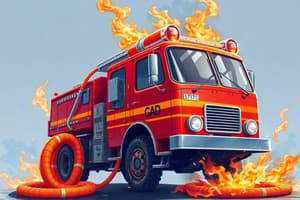Podcast
Questions and Answers
What is the use of supply hose?
What is the use of supply hose?
- To operate on a fire
- To supply water to the scene (correct)
What is the primary purpose of attack lines?
What is the primary purpose of attack lines?
- To operate on a fire (correct)
- To supply water to the scene
What is the diameter range for large diameter hose (LDH)?
What is the diameter range for large diameter hose (LDH)?
3-1/2” or larger
The outer cover of the 5” hose used by the Buffalo Fire Department is made of ______.
The outer cover of the 5” hose used by the Buffalo Fire Department is made of ______.
Soft suction hoses are used for supplying water from hydrants.
Soft suction hoses are used for supplying water from hydrants.
What is the primary cause of mechanical damage to hoses?
What is the primary cause of mechanical damage to hoses?
How many lengths of hard suction hose are carried by each engine company?
How many lengths of hard suction hose are carried by each engine company?
What is the construction of the inner liner of 1-3/4” and 2-1/2” hoses?
What is the construction of the inner liner of 1-3/4” and 2-1/2” hoses?
Chemical damage occurs due to contact with substances such as acids, bases, and ______.
Chemical damage occurs due to contact with substances such as acids, bases, and ______.
Flashcards are hidden until you start studying
Study Notes
Buffalo Fire Department Hose
- Objective of this Lesson: To understand the various classification and types of hoses used by Buffalo Fire Department (BFD) and their specific applications.
- Hose Classification:
- Supply Hose: Delivers water to the fire scene.
- Attack Hose: Used to apply water directly onto the fire.
- Specific Classifications:
- Supply Hose:
- Hard Suction Hose: Used to draw water from a draft source; comes in 4-1/2", 5", and 6" diameters.
- Soft Suction Hose: Used to draw water from hydrants; comes in 5" and 6" diameters.
- Large Diameter Hose (LDH): Used to deliver a large volume of water with minimal friction loss; comes in diameters of 3-1/2", 4", and 5".
- Attack Lines: Used to apply water directly on fire; comes in 1-3/4" and 2-1/2" diameters.
- Supply Hose:
- Hose Construction:
- 1-3/4" and 2-1/2" Hose: Constructed with a rubber inner liner for leak prevention and reducing friction. The outer jacket can be made of cotton and synthetic or all synthetic materials.
- 5" Hose (BFD Usage): 3-ply construction with
- Outer cover: Ribbed synthetic nitrile rubber.
- Reinforcement: 100% circular woven polyester twill weave.
- Inner liner: Ultra smooth, synthetic nitrile rubber.
- Primary Causes of Hose Damage:
- Mechanical damage: Cuts, abrasions, and chafing.
- Chemical damage: Contact with acids, bases, gasoline, oil, paints, or other chemicals.
- Heat damage: Embers, flames, and indirect heat can damage the hose jacket and/or liner.
- Special Procedures:
- Hose exposed to acids or bases should be thoroughly flushed at the fire scene.
- Prevent the runoff water from entering sewers or ground water supply.
Studying That Suits You
Use AI to generate personalized quizzes and flashcards to suit your learning preferences.



